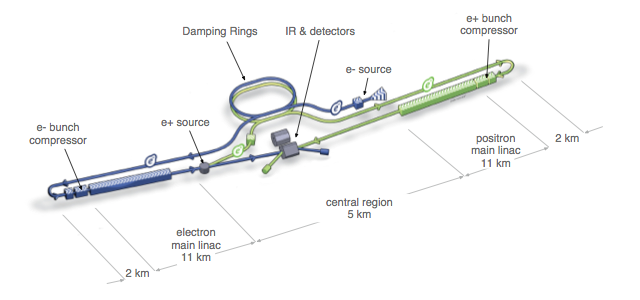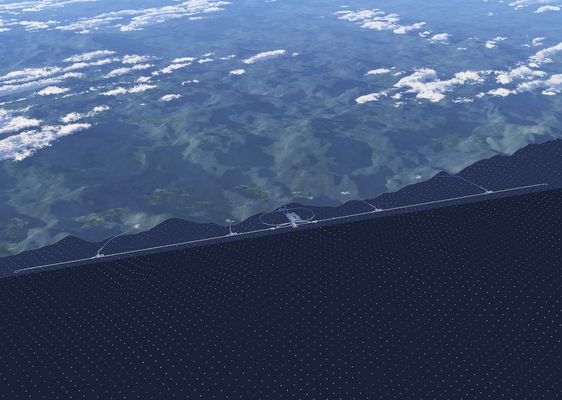
(figure by Rey.Hori/KEK)
The ILC is a particle collider, whose aim is to investigate the nature of elementary particles. It's like an extremely powerful microscope, which we will use to look at the nature of the universe we inhabit at the smallest scales. Particle accelerators pump energy into invisibly small particles (electrons and positrons); these particles are then made to collide, concentrating this energy into a tiny region of space-time, with very high energy density. It's a bit like reproducing the state of the universe shortly after the big bang. This allows us to produce all sorts of particles, especially ones which are unstable and have not survived from the big bang until today.
One of the most important way we will investigate the universe is to measure, with great precision, the properties of the Higgs boson. This Higgs boson is a recently (2012) discovered (but long postulated) particle, whose properties are quite different from those of all other elementary particles we know of. This is one reason we think that a detailed study of this particle will help us to more deeply understand how our universe, and the particles within it, behave. It may interact with as yet unknown particles (for example the dark matter which we think our universe contains a lot of), or it may be made of other, more fundamental, particles bound by a new type of force.
The ILC is a rather large piece of apparatus: two 10 km-long linear accelerators, one for electrons, the other for positrons, will be placed facing each other in an underground tunnel. They will accelerate bunches of particles to high energy (up to 250 GeV in the first stage of the experiment) and make them collide at a central "collision point". The advantage of a linear accelerator is that it can be relatively easily be extended to achieve higher energies. For the ILC we have ideas to increase the energy to 500 GeV, 1000 GeV, and beyond.
This is an artist's impression of how the ILC will look:

(figure by Rey.Hori/KEK)
Since the particles being collided, electrons and positrons, are each other's anti-particles, they can annihilate, creating a burst of energy. This energy burst then almost instantaneously recondenses into particles, usually of a different type than the initial particles. This allows us to create particles which are not usually seen in nature, because of their very short lifetimes, and to measure their properties. While such difficult-to-produce particles are not naturally present around us today, they played an important role in the early, and much hotter, stages of our universe.
The ILC is currently in the planning stage. A Technical Design Report was published in 2012 by an international team of researchers. Also in 2012, the community of High Energy Physicists in Japan proposed to host the ILC in Japan. Since this time, efforts to get international funding for this facility are underway (it's cost is large), and the ILC design is being tailored to the expected installation site in the North-Eastern (Tohoku) region of Japan. We are now (2021) planning for a "preparatory laboratory" to complete the final tasks before construction can start, over a 4-year period.
This is how the ILC will fit into the Tohoku country-side:

(Picture courtesy of Linear Collider Collaboration)
You can see it's beautiful countryside, with rolling forested hills, which turn white in winter.
The accelerator tunnels are hidden under at least 100m of solid granite.
Just a few side access tunnels (shown in the picture) lead to the outside. We want to have a little as possible an impact
on this beautiful environment.
One or two large detectors will be installed around the collision point to record what is produced in the collisions. Such a detector can be though of as a large, complex, camera. While a usual camera records the intensity and colour of visible light (or the number and wavelength/energy of photons), a particle detector must be able to detect several different types of particle (including the photons of which light is made), over a much wider range of energies. I am part of a team studying the best way to make such a detector, with a particular emphasis on the calorimeter system, whose aim is to measure the energy of particles produced in the collisions.
The ILC will act as a seed to create a international science city in the Tohoku region, where science, technology, and industry will congregate to collaborate on projects, both large and small, to develop society in these spheres. The opportunity to be part of such a development, as well as the fundamental physics research the ILC will help perform, is a strong motivation!